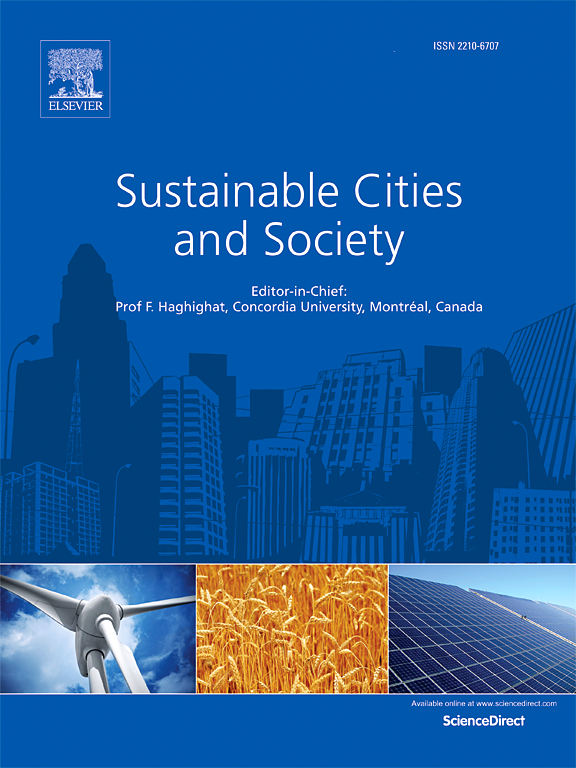诅咒还是祝福:数字普惠金融如何影响中国城市用电?
IF 10.5
1区 工程技术
Q1 CONSTRUCTION & BUILDING TECHNOLOGY
引用次数: 0
摘要
在应对气候变化的背景下,充分发挥金融工具和政策的作用至关重要。数字普惠金融是数字经济与传统金融相结合的重要产物。本研究利用2011 - 2021年中国282个城市的面板数据,探讨了DIF对城市电力消费的影响及其机制。结果表明,DIF与UEC呈显著的倒u型关系。但不同阶段、不同地区的倒u型关系表现出明显的异质性。同时,DIF通过集聚效应和技术效应与UEC产生非线性关系。此外,DIF的包容性效应显著。DIF可以缩小城市之间的电力消费差距,特别是在DIF的覆盖广度和使用深度方面。本文的理论和经验证据为理解DIF与能源利用之间的关系提供了新的发现。本文章由计算机程序翻译,如有差异,请以英文原文为准。

Curse or blessing: How does digital inclusive finance affect urban electricity consumption in China?
In the context of climate change, it is essential to give full play to the role of financial instruments and policies. Digital inclusive finance (DIF) is an important product of the combination of digital economy and traditional finance. This study uses the panel data of 282 cities in China from 2011 to 2021 to investigate the impact and mechanisms of DIF on urban electricity consumption (UEC). The results show that DIF and UEC show a significant inverted U-shaped relationship. However, the inverted U-shaped relationship shows obvious heterogeneity in different stages and regions. Meanwhile, DIF can produce the nonlinear relationship to UEC through agglomeration effect and technical effect. In addition, the inclusive effect of DIF is significant. DIF can narrow the electricity consumption gap between cities, especially in the coverage breadth and use depth of DIF. The theoretical and empirical evidence in this paper provides new findings for understanding the relationship between DIF and energy utilization.
求助全文
通过发布文献求助,成功后即可免费获取论文全文。
去求助
来源期刊

Sustainable Cities and Society
Social Sciences-Geography, Planning and Development
CiteScore
22.00
自引率
13.70%
发文量
810
审稿时长
27 days
期刊介绍:
Sustainable Cities and Society (SCS) is an international journal that focuses on fundamental and applied research to promote environmentally sustainable and socially resilient cities. The journal welcomes cross-cutting, multi-disciplinary research in various areas, including:
1. Smart cities and resilient environments;
2. Alternative/clean energy sources, energy distribution, distributed energy generation, and energy demand reduction/management;
3. Monitoring and improving air quality in built environment and cities (e.g., healthy built environment and air quality management);
4. Energy efficient, low/zero carbon, and green buildings/communities;
5. Climate change mitigation and adaptation in urban environments;
6. Green infrastructure and BMPs;
7. Environmental Footprint accounting and management;
8. Urban agriculture and forestry;
9. ICT, smart grid and intelligent infrastructure;
10. Urban design/planning, regulations, legislation, certification, economics, and policy;
11. Social aspects, impacts and resiliency of cities;
12. Behavior monitoring, analysis and change within urban communities;
13. Health monitoring and improvement;
14. Nexus issues related to sustainable cities and societies;
15. Smart city governance;
16. Decision Support Systems for trade-off and uncertainty analysis for improved management of cities and society;
17. Big data, machine learning, and artificial intelligence applications and case studies;
18. Critical infrastructure protection, including security, privacy, forensics, and reliability issues of cyber-physical systems.
19. Water footprint reduction and urban water distribution, harvesting, treatment, reuse and management;
20. Waste reduction and recycling;
21. Wastewater collection, treatment and recycling;
22. Smart, clean and healthy transportation systems and infrastructure;
 求助内容:
求助内容: 应助结果提醒方式:
应助结果提醒方式:


